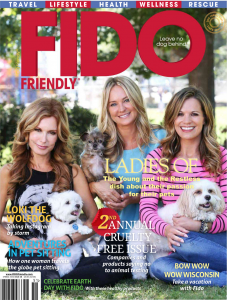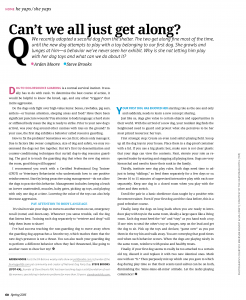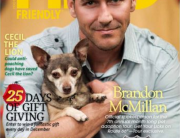My new article in the Spring 2016 issue of Fido Friendly Magazine was just released. You can see an enlargement of the page from the magazine or read the full text below.
One note: my part of the text in the magazine is usually in blue, but this time it appears in pink due to an editorial error.
Q: We recently adopted a second dog from the shelter. The two get along fine most of the time, until the new dog attempts to play with a toy belonging to our first dog. She growls and lunges at him — a behavior we’ve never seen her exhibit. Why is she not letting him play with her dog toys and what can we do about it?
Dog-to-dog resource guarding is a normal survival instinct. It usually has to do with rank. To determine the best course of action, it would be helpful to know the breed, age, and any other “triggers” that incite aggression.
Do the dogs only fight over high-value items: bones, rawhides, pig ears, antlers — or human attention, sleeping areas and food? Have there been significant puncture wounds? Pay attention to body language: a hard stare or stiffened body mean the dog is ready to strike. Prior to your new dog’s arrival, was your dog around other canines with toys on the ground? In your case, the first dog exhibits a behavior called resource guarding.
How to fix the problem? Sometimes we can fix it; others only manage it. Due to factors like owner compliance, size of dog and safety, we may recommend the dogs not live together. But let’s first try desensitization and counter-conditioning techniques that curtail dog-to-dog resource guarding. The goal is to teach the guarding dog that when the new dog enters the room, good thing will happen!
I recommend you work with a Certified Professional Dog Trainer (CPDT) or Veterinary Behaviorist who understands how to use positive reinforcement. Start by being proactive using management — do not allow the dogs to practice this behavior. Management includes: keeping a leash on (never unattended), muzzles, baby gates, picking up toys, and playing with only one dog at a time. Lowering the value of the toys can also help decrease aggression.
PAY ATTENTION TO BODY LANGUAGE
It’s vital to train your dogs to: move to another room on cue, emergency recall (come) and down-stay. Whenever you sense trouble, call the dog that listens best. Training each dog separately to “retrieve and drop” will help them learn to share!
I’ve had success teaching the non-guarding dog to move away when the guarding dog approaches a favorite toy, which teaches them that the new dog’s presence is not a threat. You can also teach your guarding dog to perform a different behavior when they feel threatened, like going to another room to chew her toy!








